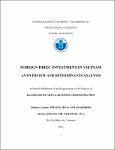| dc.description.abstract | Market economy and international integration create opportunities for every country, and Foreign Direct Investment is one of such opportunities. Like other emerging markets, Vietnam is a country that is of significant interest to investor, as it benefits from
a young population of 90 million people that is highly literate, which makes it an attractive destination for investors looking for emerging and large market. Also, the country’s labor cost is very industrious and entrepreneurial with competitively lower than countries like China or Thailand. Last but not least, an abundance of natural resources, a sophisticated financial market and a relatively stable political environment cannot be crossed out of Vietnam’s attractiveness list. Therefore, Vietnamese Government has been following the policy of FDI encouragement to take the advantages of its spillover effect. However, in recent years, the country is losing out on the opportunity. Therefore, “Why
is Vietnam trailing behind? What are the economic and non economic factors that can influence FDI? And how can Vietnam become more attractive?” are questions relating to
the conduction of this thesis.
Multiple Linear Regression analysis operated on economic data that were collected from trustworthy data sources to determine the relationship between FDI inflow and the seven factors, including market size, market growth, labor cost, inflation rate, exchange rate, level of openness to FDI and infrastructure development.
The research found that FDI strictly follows economic growth. Secondly, exchange rate is also significant determinant adjusted gradually to change market’s conditions. Next, infrastructure development is only found to be important in period
1995-2010. Being contrary to what I expected that capital always flows toward the location with lower labor cost, the FDI inflow goes up as employee’s payment increases. And so does the sign of “openness to FDI”, it is contrast to my estimation. Inflation should have been a factor having negative impact on FDI, yet it is not in my research
during 1987-2010. | en_US |


